LC458 CW1 Article Review: Social Policy & Teenage Pregnancy Decisions
VerifiedAdded on 2023/04/20
|8
|2468
|297
Report
AI Summary
This article review examines Lesley Hoggart's study on teenage pregnancy, focusing on the conflict between individual values and social policies. Hoggart's research highlights the tension between governmental policies and the autonomy of teenage mothers, particularly concerning the Social Exclusion Unit (SEU) policy in the UK. The review contrasts Hoggart's findings with other studies, emphasizing the importance of considering factors like poverty and social inequalities in shaping teenage pregnancy decisions. It also discusses the limitations of interview methodologies used in the research and analyzes the impact of social policies on young women's choices, including abortion. The review concludes that effective policies should address the root causes of teenage pregnancy rather than imposing value judgments that interfere with individual autonomy, advocating for a more comprehensive approach that considers the broader social context and personal circumstances of teenage mothers. Desklib provides this assignment solution along with numerous other resources for students.
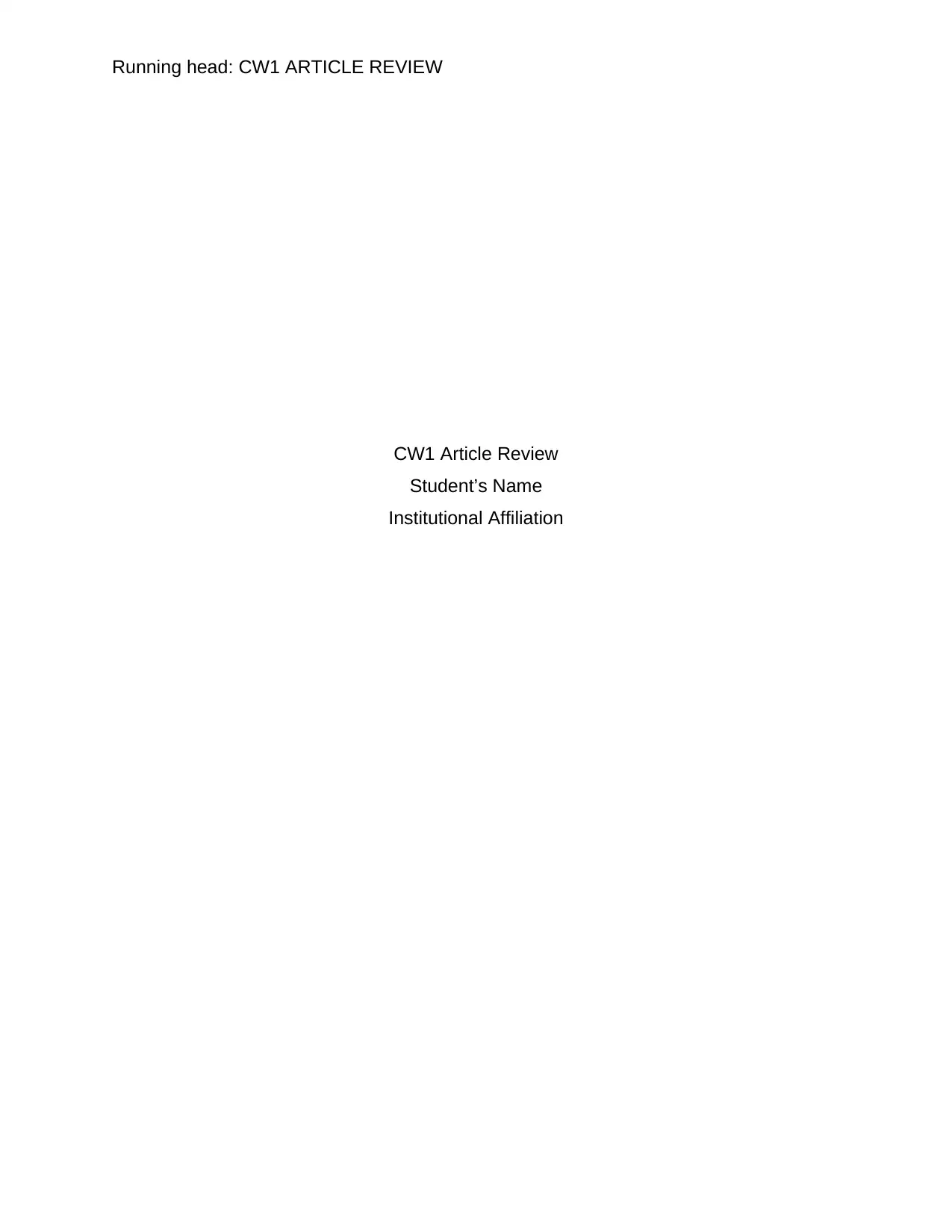
Running head: CW1 ARTICLE REVIEW
CW1 Article Review
Student’s Name
Institutional Affiliation
CW1 Article Review
Student’s Name
Institutional Affiliation
Paraphrase This Document
Need a fresh take? Get an instant paraphrase of this document with our AI Paraphraser
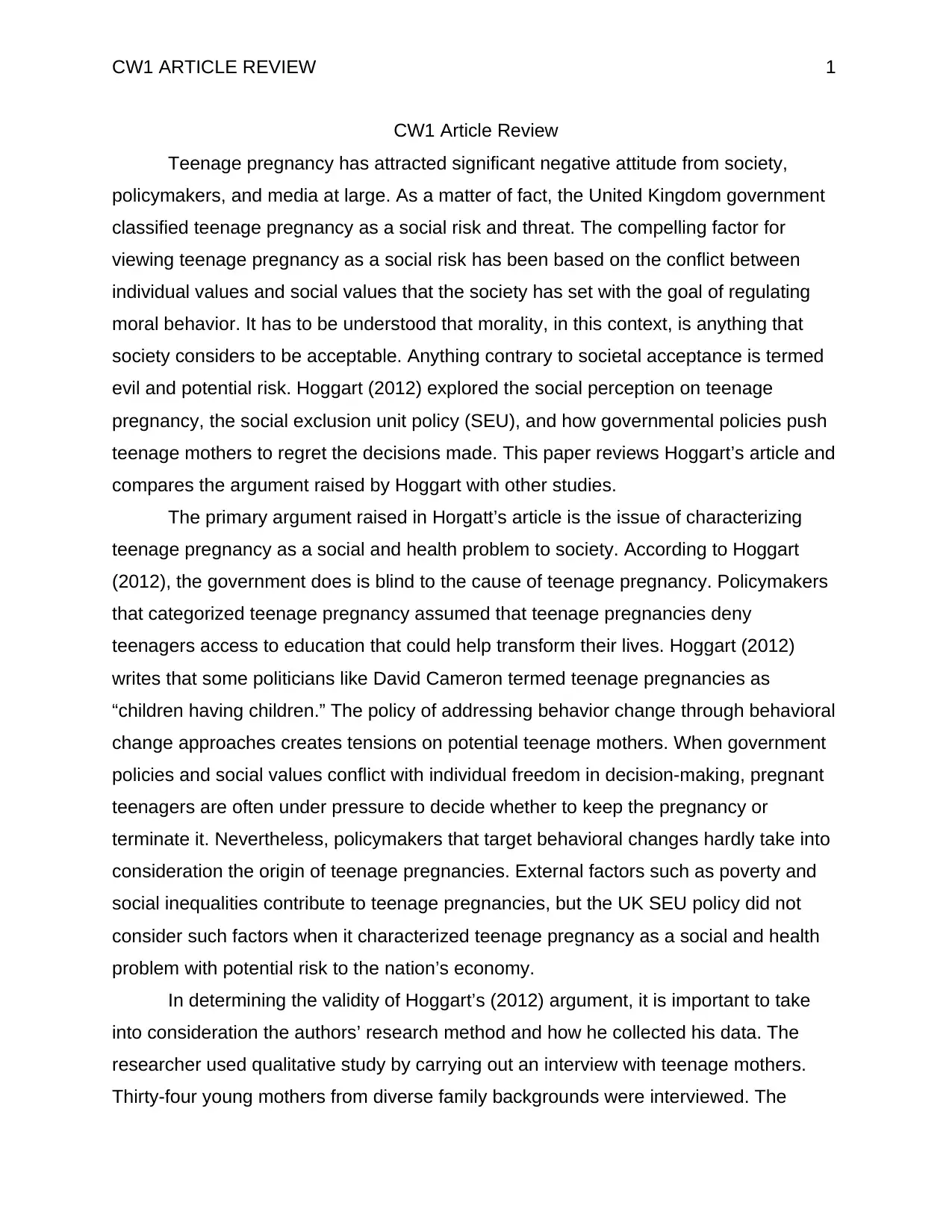
CW1 ARTICLE REVIEW 1
CW1 Article Review
Teenage pregnancy has attracted significant negative attitude from society,
policymakers, and media at large. As a matter of fact, the United Kingdom government
classified teenage pregnancy as a social risk and threat. The compelling factor for
viewing teenage pregnancy as a social risk has been based on the conflict between
individual values and social values that the society has set with the goal of regulating
moral behavior. It has to be understood that morality, in this context, is anything that
society considers to be acceptable. Anything contrary to societal acceptance is termed
evil and potential risk. Hoggart (2012) explored the social perception on teenage
pregnancy, the social exclusion unit policy (SEU), and how governmental policies push
teenage mothers to regret the decisions made. This paper reviews Hoggart’s article and
compares the argument raised by Hoggart with other studies.
The primary argument raised in Horgatt’s article is the issue of characterizing
teenage pregnancy as a social and health problem to society. According to Hoggart
(2012), the government does is blind to the cause of teenage pregnancy. Policymakers
that categorized teenage pregnancy assumed that teenage pregnancies deny
teenagers access to education that could help transform their lives. Hoggart (2012)
writes that some politicians like David Cameron termed teenage pregnancies as
“children having children.” The policy of addressing behavior change through behavioral
change approaches creates tensions on potential teenage mothers. When government
policies and social values conflict with individual freedom in decision-making, pregnant
teenagers are often under pressure to decide whether to keep the pregnancy or
terminate it. Nevertheless, policymakers that target behavioral changes hardly take into
consideration the origin of teenage pregnancies. External factors such as poverty and
social inequalities contribute to teenage pregnancies, but the UK SEU policy did not
consider such factors when it characterized teenage pregnancy as a social and health
problem with potential risk to the nation’s economy.
In determining the validity of Hoggart’s (2012) argument, it is important to take
into consideration the authors’ research method and how he collected his data. The
researcher used qualitative study by carrying out an interview with teenage mothers.
Thirty-four young mothers from diverse family backgrounds were interviewed. The
CW1 Article Review
Teenage pregnancy has attracted significant negative attitude from society,
policymakers, and media at large. As a matter of fact, the United Kingdom government
classified teenage pregnancy as a social risk and threat. The compelling factor for
viewing teenage pregnancy as a social risk has been based on the conflict between
individual values and social values that the society has set with the goal of regulating
moral behavior. It has to be understood that morality, in this context, is anything that
society considers to be acceptable. Anything contrary to societal acceptance is termed
evil and potential risk. Hoggart (2012) explored the social perception on teenage
pregnancy, the social exclusion unit policy (SEU), and how governmental policies push
teenage mothers to regret the decisions made. This paper reviews Hoggart’s article and
compares the argument raised by Hoggart with other studies.
The primary argument raised in Horgatt’s article is the issue of characterizing
teenage pregnancy as a social and health problem to society. According to Hoggart
(2012), the government does is blind to the cause of teenage pregnancy. Policymakers
that categorized teenage pregnancy assumed that teenage pregnancies deny
teenagers access to education that could help transform their lives. Hoggart (2012)
writes that some politicians like David Cameron termed teenage pregnancies as
“children having children.” The policy of addressing behavior change through behavioral
change approaches creates tensions on potential teenage mothers. When government
policies and social values conflict with individual freedom in decision-making, pregnant
teenagers are often under pressure to decide whether to keep the pregnancy or
terminate it. Nevertheless, policymakers that target behavioral changes hardly take into
consideration the origin of teenage pregnancies. External factors such as poverty and
social inequalities contribute to teenage pregnancies, but the UK SEU policy did not
consider such factors when it characterized teenage pregnancy as a social and health
problem with potential risk to the nation’s economy.
In determining the validity of Hoggart’s (2012) argument, it is important to take
into consideration the authors’ research method and how he collected his data. The
researcher used qualitative study by carrying out an interview with teenage mothers.
Thirty-four young mothers from diverse family backgrounds were interviewed. The
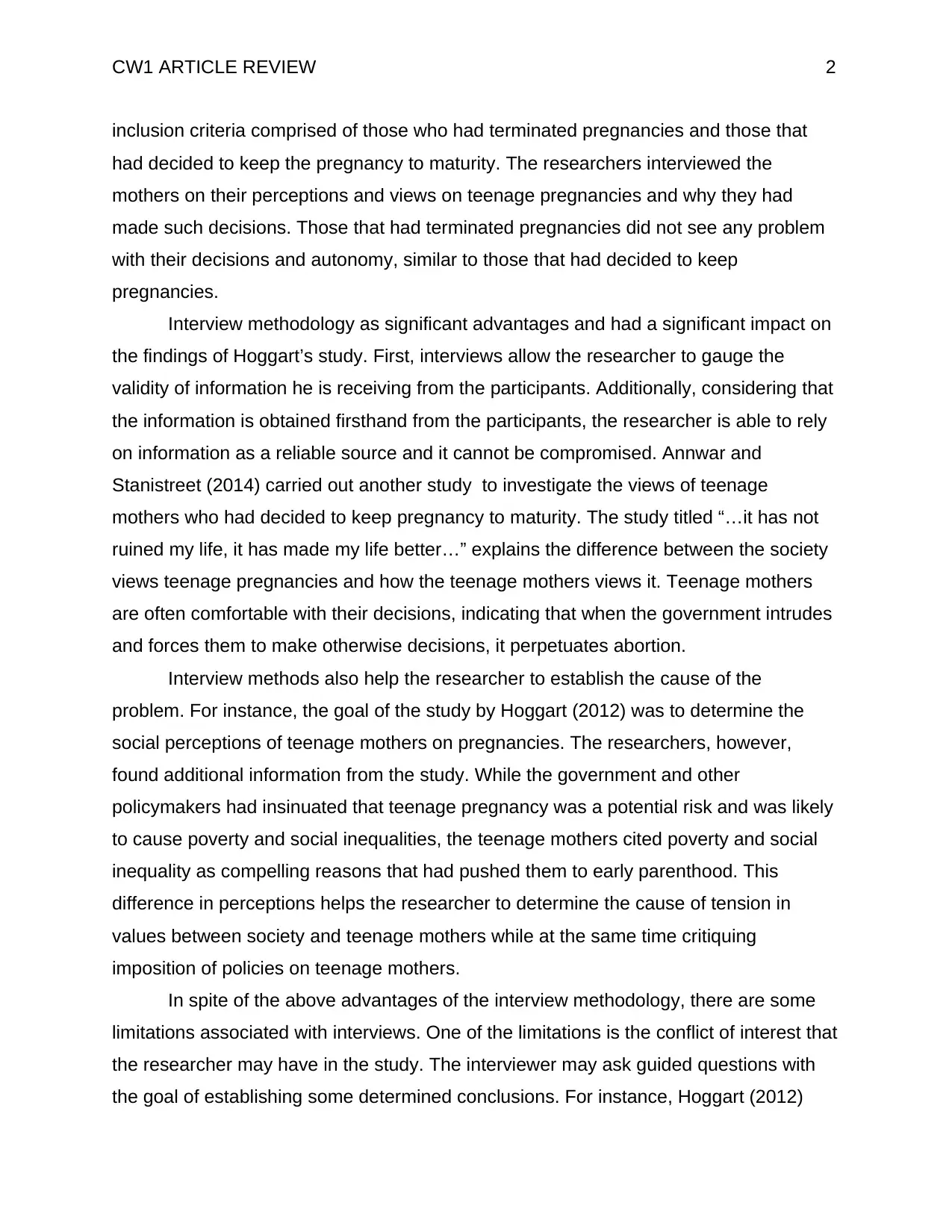
CW1 ARTICLE REVIEW 2
inclusion criteria comprised of those who had terminated pregnancies and those that
had decided to keep the pregnancy to maturity. The researchers interviewed the
mothers on their perceptions and views on teenage pregnancies and why they had
made such decisions. Those that had terminated pregnancies did not see any problem
with their decisions and autonomy, similar to those that had decided to keep
pregnancies.
Interview methodology as significant advantages and had a significant impact on
the findings of Hoggart’s study. First, interviews allow the researcher to gauge the
validity of information he is receiving from the participants. Additionally, considering that
the information is obtained firsthand from the participants, the researcher is able to rely
on information as a reliable source and it cannot be compromised. Annwar and
Stanistreet (2014) carried out another study to investigate the views of teenage
mothers who had decided to keep pregnancy to maturity. The study titled “…it has not
ruined my life, it has made my life better…” explains the difference between the society
views teenage pregnancies and how the teenage mothers views it. Teenage mothers
are often comfortable with their decisions, indicating that when the government intrudes
and forces them to make otherwise decisions, it perpetuates abortion.
Interview methods also help the researcher to establish the cause of the
problem. For instance, the goal of the study by Hoggart (2012) was to determine the
social perceptions of teenage mothers on pregnancies. The researchers, however,
found additional information from the study. While the government and other
policymakers had insinuated that teenage pregnancy was a potential risk and was likely
to cause poverty and social inequalities, the teenage mothers cited poverty and social
inequality as compelling reasons that had pushed them to early parenthood. This
difference in perceptions helps the researcher to determine the cause of tension in
values between society and teenage mothers while at the same time critiquing
imposition of policies on teenage mothers.
In spite of the above advantages of the interview methodology, there are some
limitations associated with interviews. One of the limitations is the conflict of interest that
the researcher may have in the study. The interviewer may ask guided questions with
the goal of establishing some determined conclusions. For instance, Hoggart (2012)
inclusion criteria comprised of those who had terminated pregnancies and those that
had decided to keep the pregnancy to maturity. The researchers interviewed the
mothers on their perceptions and views on teenage pregnancies and why they had
made such decisions. Those that had terminated pregnancies did not see any problem
with their decisions and autonomy, similar to those that had decided to keep
pregnancies.
Interview methodology as significant advantages and had a significant impact on
the findings of Hoggart’s study. First, interviews allow the researcher to gauge the
validity of information he is receiving from the participants. Additionally, considering that
the information is obtained firsthand from the participants, the researcher is able to rely
on information as a reliable source and it cannot be compromised. Annwar and
Stanistreet (2014) carried out another study to investigate the views of teenage
mothers who had decided to keep pregnancy to maturity. The study titled “…it has not
ruined my life, it has made my life better…” explains the difference between the society
views teenage pregnancies and how the teenage mothers views it. Teenage mothers
are often comfortable with their decisions, indicating that when the government intrudes
and forces them to make otherwise decisions, it perpetuates abortion.
Interview methods also help the researcher to establish the cause of the
problem. For instance, the goal of the study by Hoggart (2012) was to determine the
social perceptions of teenage mothers on pregnancies. The researchers, however,
found additional information from the study. While the government and other
policymakers had insinuated that teenage pregnancy was a potential risk and was likely
to cause poverty and social inequalities, the teenage mothers cited poverty and social
inequality as compelling reasons that had pushed them to early parenthood. This
difference in perceptions helps the researcher to determine the cause of tension in
values between society and teenage mothers while at the same time critiquing
imposition of policies on teenage mothers.
In spite of the above advantages of the interview methodology, there are some
limitations associated with interviews. One of the limitations is the conflict of interest that
the researcher may have in the study. The interviewer may ask guided questions with
the goal of establishing some determined conclusions. For instance, Hoggart (2012)
⊘ This is a preview!⊘
Do you want full access?
Subscribe today to unlock all pages.

Trusted by 1+ million students worldwide
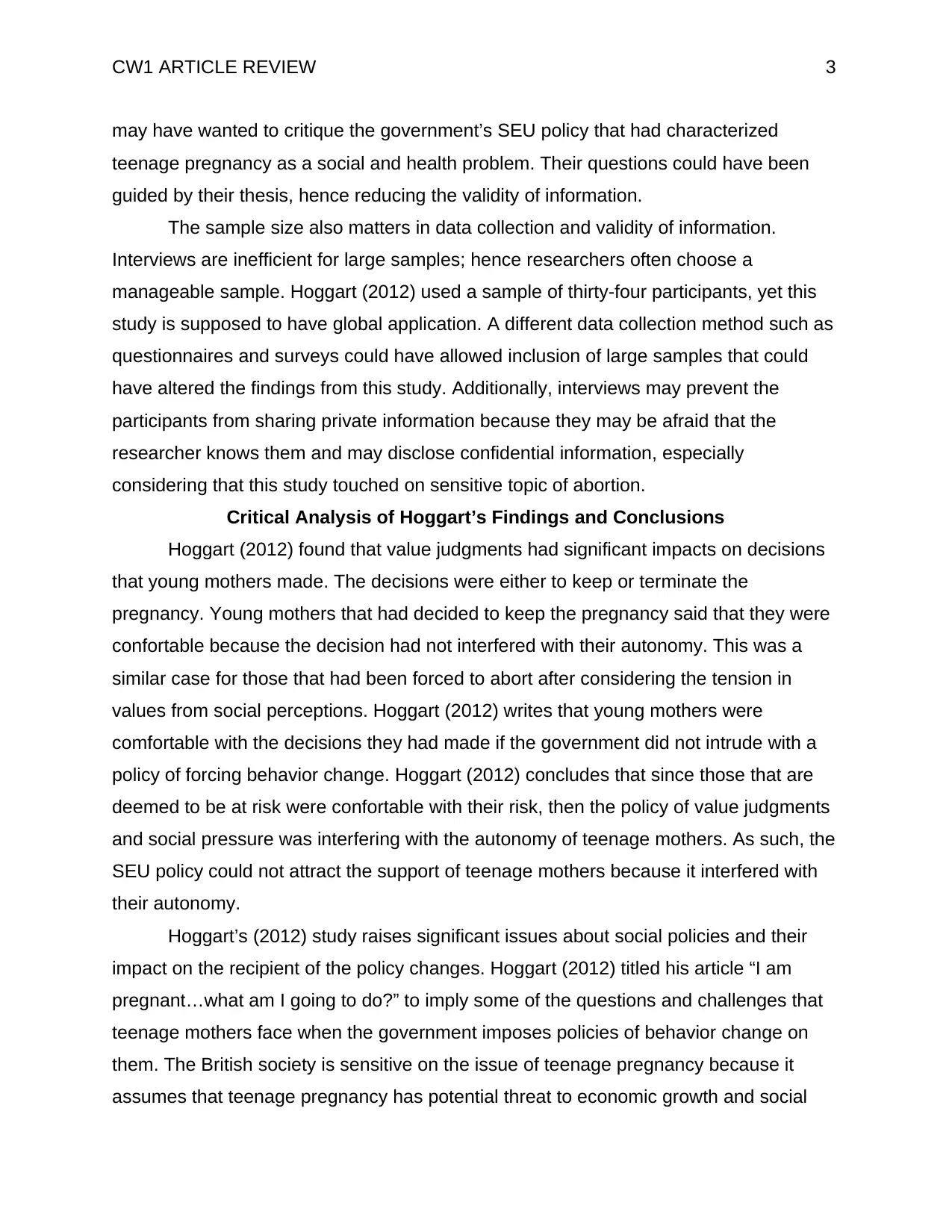
CW1 ARTICLE REVIEW 3
may have wanted to critique the government’s SEU policy that had characterized
teenage pregnancy as a social and health problem. Their questions could have been
guided by their thesis, hence reducing the validity of information.
The sample size also matters in data collection and validity of information.
Interviews are inefficient for large samples; hence researchers often choose a
manageable sample. Hoggart (2012) used a sample of thirty-four participants, yet this
study is supposed to have global application. A different data collection method such as
questionnaires and surveys could have allowed inclusion of large samples that could
have altered the findings from this study. Additionally, interviews may prevent the
participants from sharing private information because they may be afraid that the
researcher knows them and may disclose confidential information, especially
considering that this study touched on sensitive topic of abortion.
Critical Analysis of Hoggart’s Findings and Conclusions
Hoggart (2012) found that value judgments had significant impacts on decisions
that young mothers made. The decisions were either to keep or terminate the
pregnancy. Young mothers that had decided to keep the pregnancy said that they were
confortable because the decision had not interfered with their autonomy. This was a
similar case for those that had been forced to abort after considering the tension in
values from social perceptions. Hoggart (2012) writes that young mothers were
comfortable with the decisions they had made if the government did not intrude with a
policy of forcing behavior change. Hoggart (2012) concludes that since those that are
deemed to be at risk were confortable with their risk, then the policy of value judgments
and social pressure was interfering with the autonomy of teenage mothers. As such, the
SEU policy could not attract the support of teenage mothers because it interfered with
their autonomy.
Hoggart’s (2012) study raises significant issues about social policies and their
impact on the recipient of the policy changes. Hoggart (2012) titled his article “I am
pregnant…what am I going to do?” to imply some of the questions and challenges that
teenage mothers face when the government imposes policies of behavior change on
them. The British society is sensitive on the issue of teenage pregnancy because it
assumes that teenage pregnancy has potential threat to economic growth and social
may have wanted to critique the government’s SEU policy that had characterized
teenage pregnancy as a social and health problem. Their questions could have been
guided by their thesis, hence reducing the validity of information.
The sample size also matters in data collection and validity of information.
Interviews are inefficient for large samples; hence researchers often choose a
manageable sample. Hoggart (2012) used a sample of thirty-four participants, yet this
study is supposed to have global application. A different data collection method such as
questionnaires and surveys could have allowed inclusion of large samples that could
have altered the findings from this study. Additionally, interviews may prevent the
participants from sharing private information because they may be afraid that the
researcher knows them and may disclose confidential information, especially
considering that this study touched on sensitive topic of abortion.
Critical Analysis of Hoggart’s Findings and Conclusions
Hoggart (2012) found that value judgments had significant impacts on decisions
that young mothers made. The decisions were either to keep or terminate the
pregnancy. Young mothers that had decided to keep the pregnancy said that they were
confortable because the decision had not interfered with their autonomy. This was a
similar case for those that had been forced to abort after considering the tension in
values from social perceptions. Hoggart (2012) writes that young mothers were
comfortable with the decisions they had made if the government did not intrude with a
policy of forcing behavior change. Hoggart (2012) concludes that since those that are
deemed to be at risk were confortable with their risk, then the policy of value judgments
and social pressure was interfering with the autonomy of teenage mothers. As such, the
SEU policy could not attract the support of teenage mothers because it interfered with
their autonomy.
Hoggart’s (2012) study raises significant issues about social policies and their
impact on the recipient of the policy changes. Hoggart (2012) titled his article “I am
pregnant…what am I going to do?” to imply some of the questions and challenges that
teenage mothers face when the government imposes policies of behavior change on
them. The British society is sensitive on the issue of teenage pregnancy because it
assumes that teenage pregnancy has potential threat to economic growth and social
Paraphrase This Document
Need a fresh take? Get an instant paraphrase of this document with our AI Paraphraser
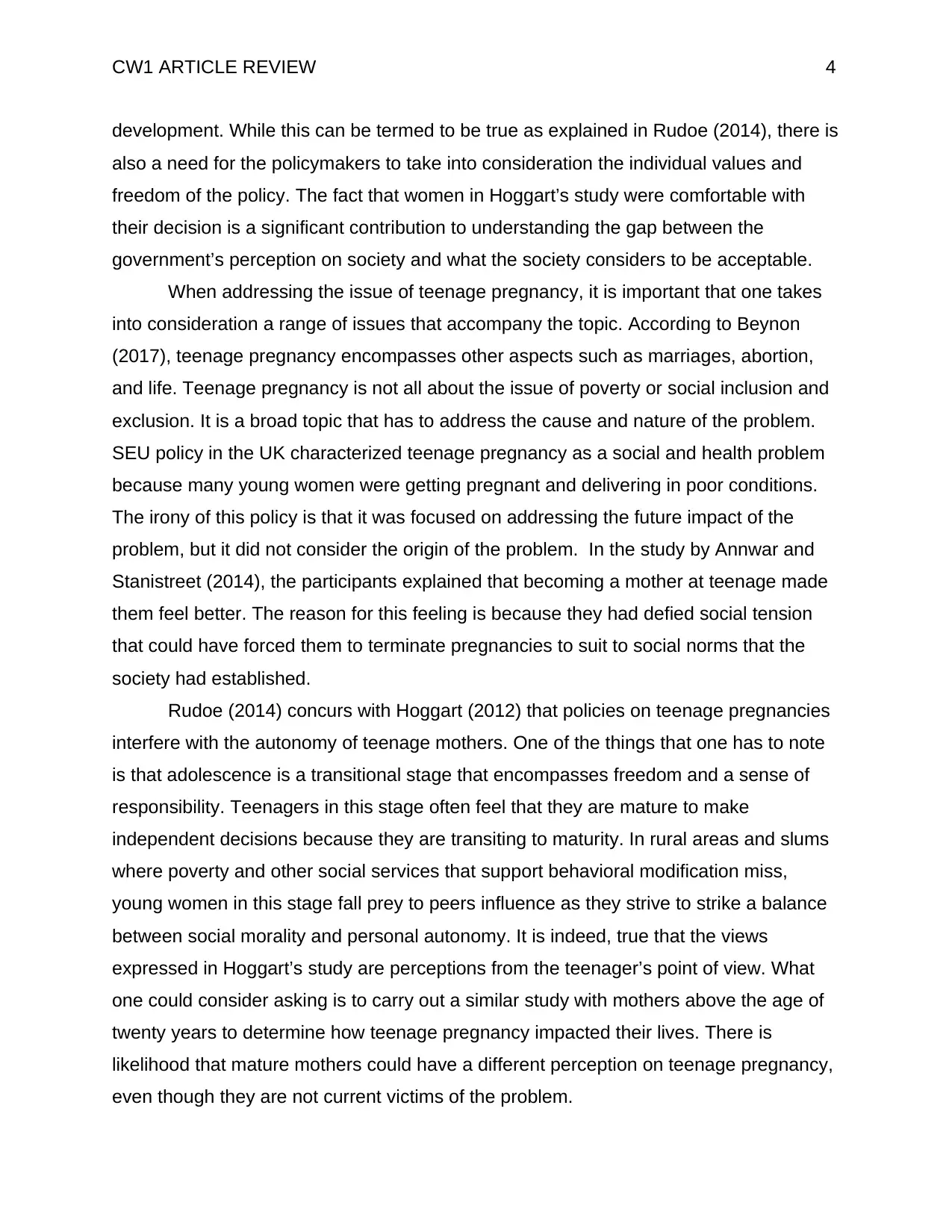
CW1 ARTICLE REVIEW 4
development. While this can be termed to be true as explained in Rudoe (2014), there is
also a need for the policymakers to take into consideration the individual values and
freedom of the policy. The fact that women in Hoggart’s study were comfortable with
their decision is a significant contribution to understanding the gap between the
government’s perception on society and what the society considers to be acceptable.
When addressing the issue of teenage pregnancy, it is important that one takes
into consideration a range of issues that accompany the topic. According to Beynon
(2017), teenage pregnancy encompasses other aspects such as marriages, abortion,
and life. Teenage pregnancy is not all about the issue of poverty or social inclusion and
exclusion. It is a broad topic that has to address the cause and nature of the problem.
SEU policy in the UK characterized teenage pregnancy as a social and health problem
because many young women were getting pregnant and delivering in poor conditions.
The irony of this policy is that it was focused on addressing the future impact of the
problem, but it did not consider the origin of the problem. In the study by Annwar and
Stanistreet (2014), the participants explained that becoming a mother at teenage made
them feel better. The reason for this feeling is because they had defied social tension
that could have forced them to terminate pregnancies to suit to social norms that the
society had established.
Rudoe (2014) concurs with Hoggart (2012) that policies on teenage pregnancies
interfere with the autonomy of teenage mothers. One of the things that one has to note
is that adolescence is a transitional stage that encompasses freedom and a sense of
responsibility. Teenagers in this stage often feel that they are mature to make
independent decisions because they are transiting to maturity. In rural areas and slums
where poverty and other social services that support behavioral modification miss,
young women in this stage fall prey to peers influence as they strive to strike a balance
between social morality and personal autonomy. It is indeed, true that the views
expressed in Hoggart’s study are perceptions from the teenager’s point of view. What
one could consider asking is to carry out a similar study with mothers above the age of
twenty years to determine how teenage pregnancy impacted their lives. There is
likelihood that mature mothers could have a different perception on teenage pregnancy,
even though they are not current victims of the problem.
development. While this can be termed to be true as explained in Rudoe (2014), there is
also a need for the policymakers to take into consideration the individual values and
freedom of the policy. The fact that women in Hoggart’s study were comfortable with
their decision is a significant contribution to understanding the gap between the
government’s perception on society and what the society considers to be acceptable.
When addressing the issue of teenage pregnancy, it is important that one takes
into consideration a range of issues that accompany the topic. According to Beynon
(2017), teenage pregnancy encompasses other aspects such as marriages, abortion,
and life. Teenage pregnancy is not all about the issue of poverty or social inclusion and
exclusion. It is a broad topic that has to address the cause and nature of the problem.
SEU policy in the UK characterized teenage pregnancy as a social and health problem
because many young women were getting pregnant and delivering in poor conditions.
The irony of this policy is that it was focused on addressing the future impact of the
problem, but it did not consider the origin of the problem. In the study by Annwar and
Stanistreet (2014), the participants explained that becoming a mother at teenage made
them feel better. The reason for this feeling is because they had defied social tension
that could have forced them to terminate pregnancies to suit to social norms that the
society had established.
Rudoe (2014) concurs with Hoggart (2012) that policies on teenage pregnancies
interfere with the autonomy of teenage mothers. One of the things that one has to note
is that adolescence is a transitional stage that encompasses freedom and a sense of
responsibility. Teenagers in this stage often feel that they are mature to make
independent decisions because they are transiting to maturity. In rural areas and slums
where poverty and other social services that support behavioral modification miss,
young women in this stage fall prey to peers influence as they strive to strike a balance
between social morality and personal autonomy. It is indeed, true that the views
expressed in Hoggart’s study are perceptions from the teenager’s point of view. What
one could consider asking is to carry out a similar study with mothers above the age of
twenty years to determine how teenage pregnancy impacted their lives. There is
likelihood that mature mothers could have a different perception on teenage pregnancy,
even though they are not current victims of the problem.
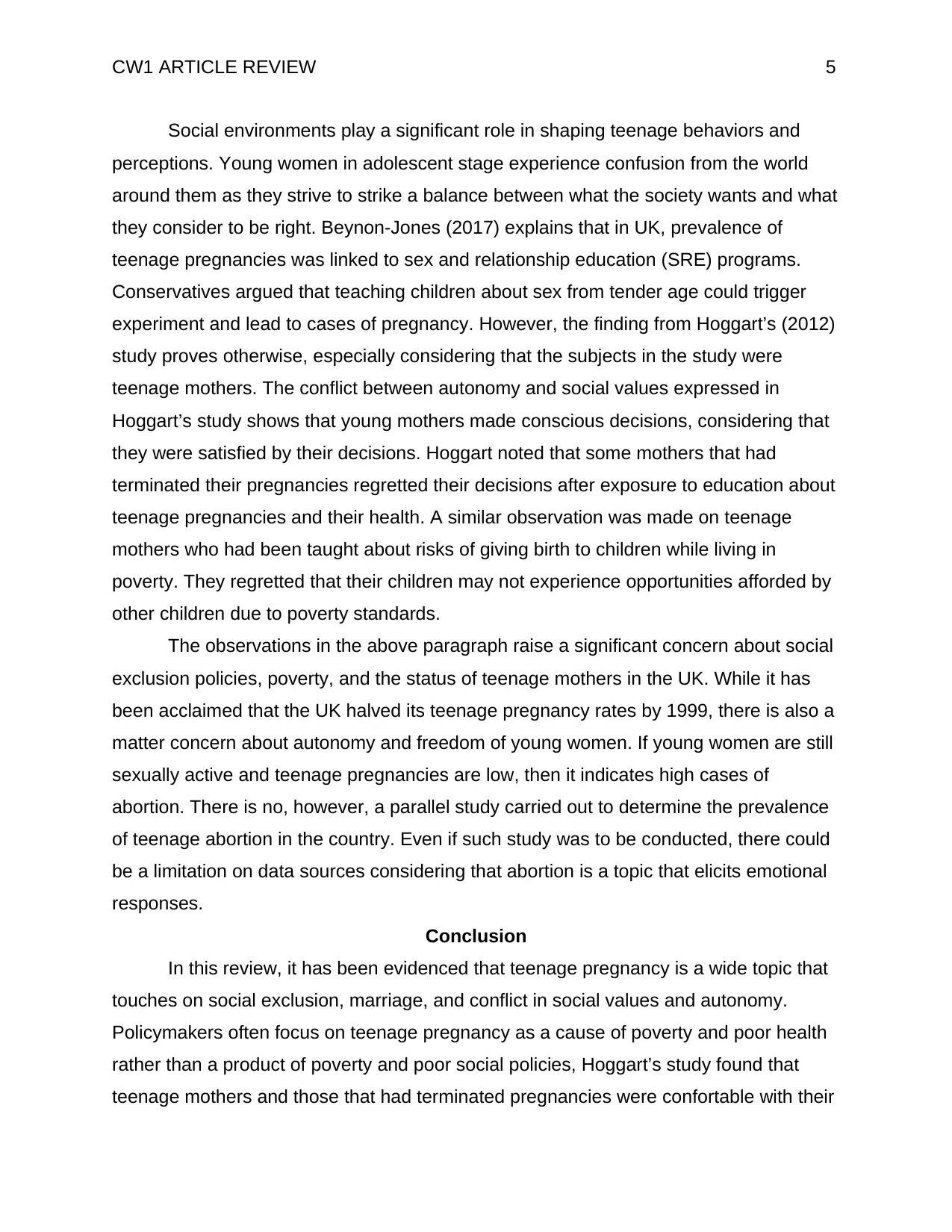
CW1 ARTICLE REVIEW 5
Social environments play a significant role in shaping teenage behaviors and
perceptions. Young women in adolescent stage experience confusion from the world
around them as they strive to strike a balance between what the society wants and what
they consider to be right. Beynon-Jones (2017) explains that in UK, prevalence of
teenage pregnancies was linked to sex and relationship education (SRE) programs.
Conservatives argued that teaching children about sex from tender age could trigger
experiment and lead to cases of pregnancy. However, the finding from Hoggart’s (2012)
study proves otherwise, especially considering that the subjects in the study were
teenage mothers. The conflict between autonomy and social values expressed in
Hoggart’s study shows that young mothers made conscious decisions, considering that
they were satisfied by their decisions. Hoggart noted that some mothers that had
terminated their pregnancies regretted their decisions after exposure to education about
teenage pregnancies and their health. A similar observation was made on teenage
mothers who had been taught about risks of giving birth to children while living in
poverty. They regretted that their children may not experience opportunities afforded by
other children due to poverty standards.
The observations in the above paragraph raise a significant concern about social
exclusion policies, poverty, and the status of teenage mothers in the UK. While it has
been acclaimed that the UK halved its teenage pregnancy rates by 1999, there is also a
matter concern about autonomy and freedom of young women. If young women are still
sexually active and teenage pregnancies are low, then it indicates high cases of
abortion. There is no, however, a parallel study carried out to determine the prevalence
of teenage abortion in the country. Even if such study was to be conducted, there could
be a limitation on data sources considering that abortion is a topic that elicits emotional
responses.
Conclusion
In this review, it has been evidenced that teenage pregnancy is a wide topic that
touches on social exclusion, marriage, and conflict in social values and autonomy.
Policymakers often focus on teenage pregnancy as a cause of poverty and poor health
rather than a product of poverty and poor social policies, Hoggart’s study found that
teenage mothers and those that had terminated pregnancies were confortable with their
Social environments play a significant role in shaping teenage behaviors and
perceptions. Young women in adolescent stage experience confusion from the world
around them as they strive to strike a balance between what the society wants and what
they consider to be right. Beynon-Jones (2017) explains that in UK, prevalence of
teenage pregnancies was linked to sex and relationship education (SRE) programs.
Conservatives argued that teaching children about sex from tender age could trigger
experiment and lead to cases of pregnancy. However, the finding from Hoggart’s (2012)
study proves otherwise, especially considering that the subjects in the study were
teenage mothers. The conflict between autonomy and social values expressed in
Hoggart’s study shows that young mothers made conscious decisions, considering that
they were satisfied by their decisions. Hoggart noted that some mothers that had
terminated their pregnancies regretted their decisions after exposure to education about
teenage pregnancies and their health. A similar observation was made on teenage
mothers who had been taught about risks of giving birth to children while living in
poverty. They regretted that their children may not experience opportunities afforded by
other children due to poverty standards.
The observations in the above paragraph raise a significant concern about social
exclusion policies, poverty, and the status of teenage mothers in the UK. While it has
been acclaimed that the UK halved its teenage pregnancy rates by 1999, there is also a
matter concern about autonomy and freedom of young women. If young women are still
sexually active and teenage pregnancies are low, then it indicates high cases of
abortion. There is no, however, a parallel study carried out to determine the prevalence
of teenage abortion in the country. Even if such study was to be conducted, there could
be a limitation on data sources considering that abortion is a topic that elicits emotional
responses.
Conclusion
In this review, it has been evidenced that teenage pregnancy is a wide topic that
touches on social exclusion, marriage, and conflict in social values and autonomy.
Policymakers often focus on teenage pregnancy as a cause of poverty and poor health
rather than a product of poverty and poor social policies, Hoggart’s study found that
teenage mothers and those that had terminated pregnancies were confortable with their
⊘ This is a preview!⊘
Do you want full access?
Subscribe today to unlock all pages.

Trusted by 1+ million students worldwide
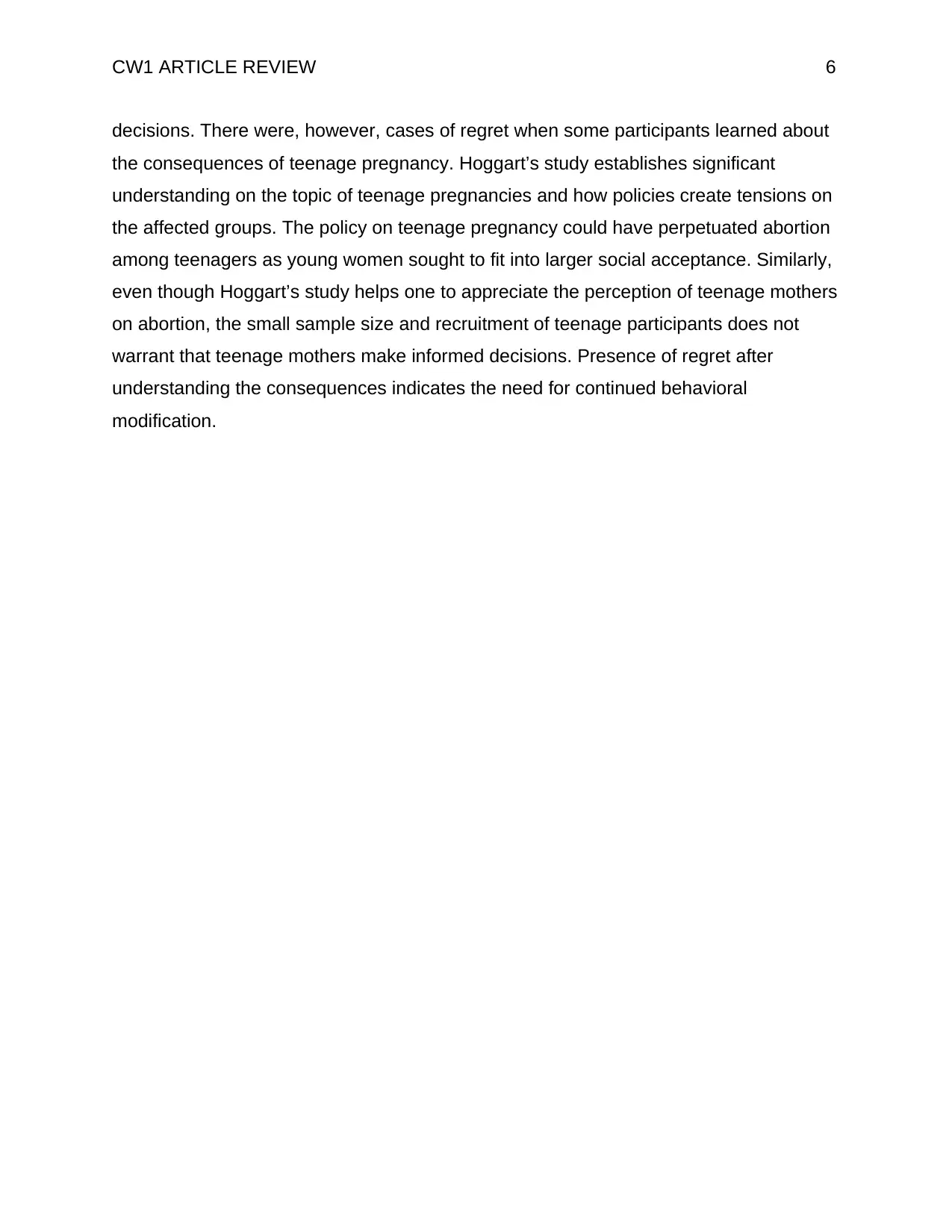
CW1 ARTICLE REVIEW 6
decisions. There were, however, cases of regret when some participants learned about
the consequences of teenage pregnancy. Hoggart’s study establishes significant
understanding on the topic of teenage pregnancies and how policies create tensions on
the affected groups. The policy on teenage pregnancy could have perpetuated abortion
among teenagers as young women sought to fit into larger social acceptance. Similarly,
even though Hoggart’s study helps one to appreciate the perception of teenage mothers
on abortion, the small sample size and recruitment of teenage participants does not
warrant that teenage mothers make informed decisions. Presence of regret after
understanding the consequences indicates the need for continued behavioral
modification.
decisions. There were, however, cases of regret when some participants learned about
the consequences of teenage pregnancy. Hoggart’s study establishes significant
understanding on the topic of teenage pregnancies and how policies create tensions on
the affected groups. The policy on teenage pregnancy could have perpetuated abortion
among teenagers as young women sought to fit into larger social acceptance. Similarly,
even though Hoggart’s study helps one to appreciate the perception of teenage mothers
on abortion, the small sample size and recruitment of teenage participants does not
warrant that teenage mothers make informed decisions. Presence of regret after
understanding the consequences indicates the need for continued behavioral
modification.
Paraphrase This Document
Need a fresh take? Get an instant paraphrase of this document with our AI Paraphraser
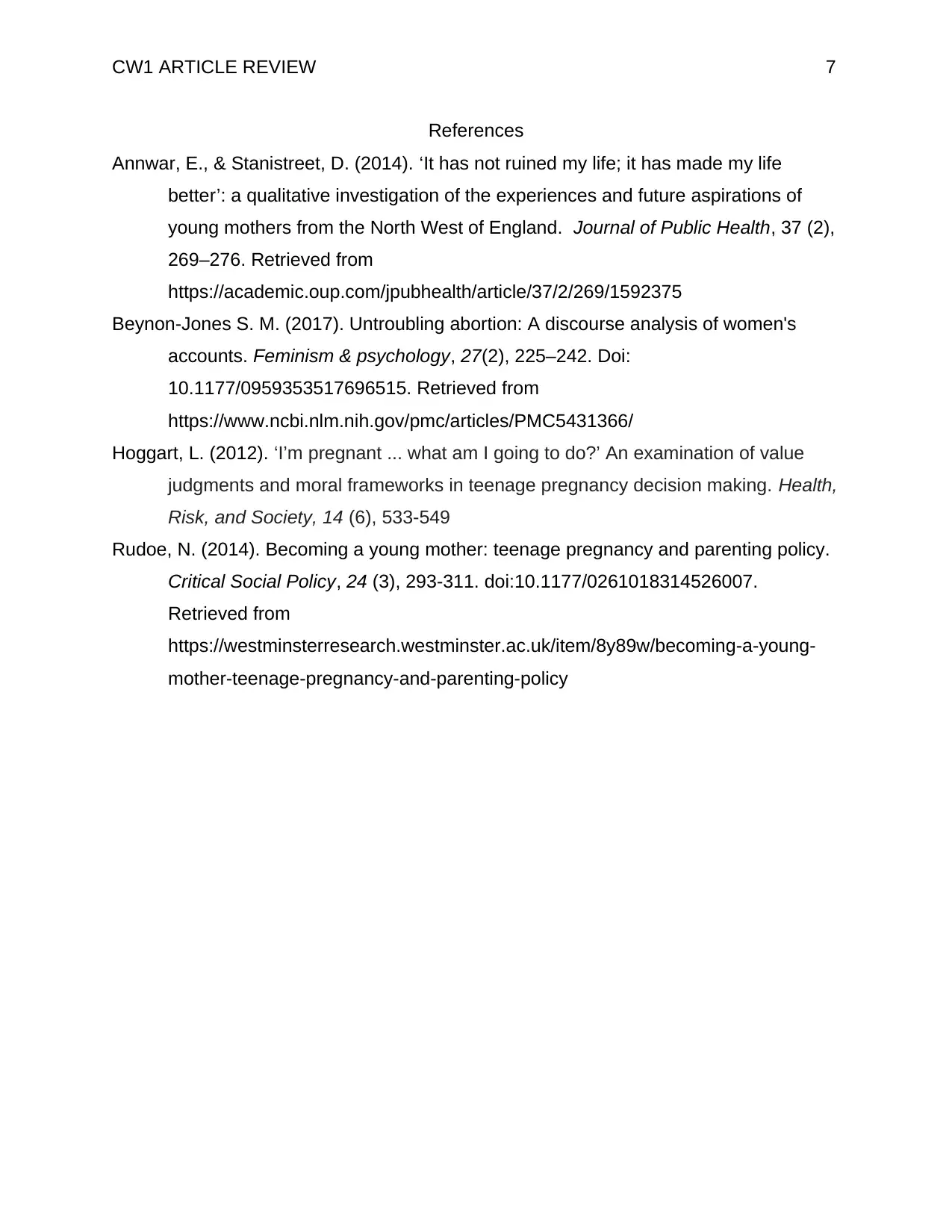
CW1 ARTICLE REVIEW 7
References
Annwar, E., & Stanistreet, D. (2014). ‘It has not ruined my life; it has made my life
better’: a qualitative investigation of the experiences and future aspirations of
young mothers from the North West of England. Journal of Public Health, 37 (2),
269–276. Retrieved from
https://academic.oup.com/jpubhealth/article/37/2/269/1592375
Beynon-Jones S. M. (2017). Untroubling abortion: A discourse analysis of women's
accounts. Feminism & psychology, 27(2), 225–242. Doi:
10.1177/0959353517696515. Retrieved from
https://www.ncbi.nlm.nih.gov/pmc/articles/PMC5431366/
Hoggart, L. (2012). ‘I’m pregnant ... what am I going to do?’ An examination of value
judgments and moral frameworks in teenage pregnancy decision making. Health,
Risk, and Society, 14 (6), 533-549
Rudoe, N. (2014). Becoming a young mother: teenage pregnancy and parenting policy.
Critical Social Policy, 24 (3), 293-311. doi:10.1177/0261018314526007.
Retrieved from
https://westminsterresearch.westminster.ac.uk/item/8y89w/becoming-a-young-
mother-teenage-pregnancy-and-parenting-policy
References
Annwar, E., & Stanistreet, D. (2014). ‘It has not ruined my life; it has made my life
better’: a qualitative investigation of the experiences and future aspirations of
young mothers from the North West of England. Journal of Public Health, 37 (2),
269–276. Retrieved from
https://academic.oup.com/jpubhealth/article/37/2/269/1592375
Beynon-Jones S. M. (2017). Untroubling abortion: A discourse analysis of women's
accounts. Feminism & psychology, 27(2), 225–242. Doi:
10.1177/0959353517696515. Retrieved from
https://www.ncbi.nlm.nih.gov/pmc/articles/PMC5431366/
Hoggart, L. (2012). ‘I’m pregnant ... what am I going to do?’ An examination of value
judgments and moral frameworks in teenage pregnancy decision making. Health,
Risk, and Society, 14 (6), 533-549
Rudoe, N. (2014). Becoming a young mother: teenage pregnancy and parenting policy.
Critical Social Policy, 24 (3), 293-311. doi:10.1177/0261018314526007.
Retrieved from
https://westminsterresearch.westminster.ac.uk/item/8y89w/becoming-a-young-
mother-teenage-pregnancy-and-parenting-policy
1 out of 8
Your All-in-One AI-Powered Toolkit for Academic Success.
+13062052269
info@desklib.com
Available 24*7 on WhatsApp / Email
![[object Object]](/_next/static/media/star-bottom.7253800d.svg)
Unlock your academic potential
Copyright © 2020–2025 A2Z Services. All Rights Reserved. Developed and managed by ZUCOL.
